January 18 / 79
We have been waiting a long month for tonight’s meeting and it
is my privilege to introduce our guest speaker. We are fortunate
to have him share his talent for story telling with us.
(John) Sandy Davison left Hantsport as a young man for Mt. A
in 1921, then graduating from N.S.Tech. in 1925.
He worked as a Junior Engineer with the Canadian International
Paper Co. in Three Rivers Que. until 1926 when he moved to
Can. Comstock – now known as Can. International – and until 1939
directed projects in the Eastern Provinces.
At that time he was loaned to The Aluminum Co. of Canada and
was in charge of Industrial installations across Canada, in India
and South America. This was an exciting move in Sandy’s
career as at that time he acquired a charming Sec’y who later
became his wife.
After the war he returned to Comstock as Manager of their Electrical
Division, becoming General Mgr. And Vice Pres. of Quebec and the
Maritimes – a position he held until his retirement in 1964
when he with Trudy and daughter Jill returned to his home town.
As well as being a member of several Groups and Institutes
connected with his profession he also was a member of private
Fish and Game Clubs in Quebec.
Ladies and gentlemen I ask you to welcome Sandy Davison with
tales of his youth in Hantsport – – –
Jan. 17 1979
(signed) A R Clark
[Allister R. Clark, President of Hantsport & Area Historical Society]
Address by J. L. Davison to Historic Society, Hantsport, Jan. 17/79
Ladies and Gentlemen:
I sort of got this job thrust on me by a kinsman of mine; in
a weak moment, I agreed to it. They say when you get older you
get garrulous and try to talk to people that are not too interested
and when the time comes that you have an audience, you are sort of
reluctant…and that’s how I am right now, reluctant.
Anyway, I was supposed to talk about my growing-up period
in Hantsport and after thinking about it, it would take only about
ten minutes to describe all the things that happened to me, but
along with it, I would like to talk about the town of Hantsport
as it was while I was growing up and what happened to it.
I am talking about just after I can remember things now,
about 1904 and 5. There were no street lights, no water, no
sewer, plenty of beautiful trees which they have let die and I
think they should try to replant a lot of them. The streets
were gravel, a very poor grade of gravel, and after a rainstorm
you had to wear rubbers or you had some awful dirty shoes. In
the spring, because there was no sewer, it flooded. To get up Prince
street to school I used to have to wander all around back lots
to get around big pools that formed from water that came down
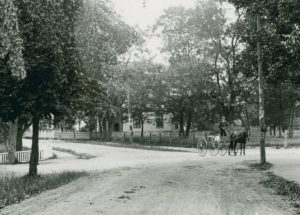
from the John Churchill property, went right through what was
Reid’s house and when winter came, sometimes that would freeze and
we would have – skating right behind Laurie Pattison’s place.
There were nice neat fences around the town with gates and
I think they were partly there to keep out the cows, as a lot of
people kept cows, and if you were a lucky boy and drove the cow
from say April to the next late September, maybe October, back
and forth every day, Sunday included, you might get five dollars
–that was the going rate for driving cattle. People kept pigs,
2
kept hens.
There were no street lights. At night time, people, par-
ticularly elderly people, carried lanterns and if you looked out
at night, you would see dim lights coming out of
houses; that was people getting around the town.
Because there was no water system, people had roof water
for washing and wells for drinking water. If you had a horse,
you had two places to water it–Willow Brook and a spring that
let out from the present Community Centre property into the road
going to Mt. Denson. Many a time I’ve driven our horse down there
to get water on the way to Mt. Denson.
Later on, some kind soul donated a cast iron fountain that
sat on the corner of Main and William Streets. It had a trough
for horses and a bowl down below for cats and dogs right near
the sidewalk. I don’t know what happened to it. It was in the
old town hall for years. The old town fountain.
During those early days, oddly enough people going to Mt.
Denson didn’t go by Mt. Denson, they used the Bog Road. The
Mount Denson Road wasn’t very good, it was longer, so the Bog Road
was the way to go to Windsor. It was in about the same shape
it’s in now. On a dry summer day you couldn’t see anything for about
an hour for dust. I can remember Ed Woollaver used to tie a
spruce tree behind his car and go up as fast as he could. That
would prevent anyone following him for a good long time. Bog
Road was originally promoted by my Great Grandfather, Asa. He
had moved here from Falmouth. The way to go to Windsor in the
early days was to go up Holmes Hill and cross over at the end
of Rand Street down through that ravine like thing across a small
bridge over the Halfway River, then up into Mt. Denson
by the Schurman Road. They tell me there is still
3
evidence of the old piers still there. It was awkward apparently,
so old Asa promoted this Bog Road.
When I was real young, we used to go up there and have horse
races on the Shay Lake. They’d go up there and drink plenty of
hard cider, build fires, and race horses–quite an event.
I want to describe the town as it was then. The stores
oddly enough, were not much different than they are today.
If you were coming down Holmes Hill toward Kings County, the
first store you met on the west side was a little store that a
woman called Mrs. Jordan, who was a milliner, had (that was recently
Fred’s Clothing Store.) The next part of the store, there was a
variety of people in it, probably the most famous was a Parker
named Craig. As you worked along you came to Pattison’s Tin
-
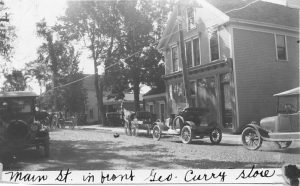
Dunbar – Curry Store
Smith Store, Dunbar’s Dry Good Store which is a submarine sandwich
place today. A butcher store that Mr. Gertridge had, Pentz’s
Drug Store, Pulsifer’s Shoe Store and way up in Kings County was
North’s Store which was kind of a general store. Coming back
on the other side, first met was Robert Lawrence’s Shoe Store and
then on to the corner of Prince Street there was a store held by
a variety of people, first one I really remember was Mrs. Dickson;
she had a kind of general store there. On the way up was Mr. Borden’s
Undertaking Parlour. No more business establishment up Main Street.
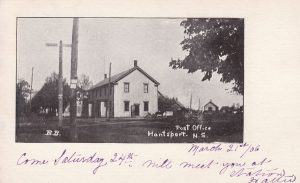
On William Street, coming up from the wharf, was my father’s
store, directly across from the Customs Officer, George Comstock,
James Morgan’s barbershop, Customs Office, Jim Lawrence. Wasn’t
any town hall, the post office was part of what is now the Union
Building. Then Sim Michener sold ice cream, had a billiard parlor
and made spruce beer and some other kinds of more dubious kinds of
beer. Always had a very sour smell about the whole place.
4
Across the street was . They had a grocery
store where Harvie’s had a store for so long. Nothing more, al-
though just prior to my time there was a store where the post office
now is. That was owned by Harry Davison, that was William Davison’s
son. It was either burned down or was torn down, I don’t know which.
Yeaton’s Store that sold candy was on the corner and Hantsport Hotel
(Mort Wall) and adjacent to it the American House run by a man
named [Edward Dalton]. He either fell off the wharf or jumped off–
nobody knew which but in any event, he drowned one day about noon.
Next place up the street was Sweets Hall, upstairs rented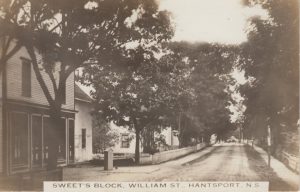
for meetings (now Barber Shop).
On Prince Street, the first place was Newcomb’s Hardware
store. On the left, going up, was Rufus Comstock’s Blacksmith Shop.
There wasn’t another business establishment on Prince Street.
Those were the business people and places that I first remember.
On Avon Street here was no business except Mr. Kelsey
Francis had a shop where he repaired mill machinery. I used to
watch him, he was wonderful to watch, the tools looked as though
he had just bought them, shiny, no shavings on the floor; it was
cleaner than most people’s kitchen. He used to turn out exceptionally
fine work, but I believe half the people in town didn’t know what
Kelsey Francis did. Shop’s still there. I don’t know what’s
happened to his tools. He was a fine man and a fine tradesman.
On Tannery Road there was the remains of the old Tannery
that had been there for a long time. It got its water from the
Willow Brook. A little later, David Pulsifer had a cooper shop
there. It was fun to watch him make apple barrels–How fast he
could make them.
5
The Station was where it is now and one of the apple warehouses,
the one nearest to William Street, was there. It had been a store
run by Tr Coffill and George Davison. George was Al Lawrence’s
wife’s father. I don’t know how long it lasted, when I first knew
-
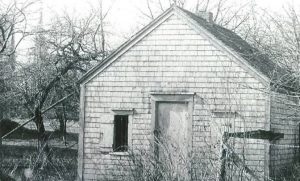
Hantsport Jail
it it was an apple warehouse. There was a jail back of Yeaton’s,
really kind of a shed. I don’t know of anyone really incarcerated
there but this tramp, Pokey Ned, used to live there in the summers.
And right there was Yeaton’s pig pen, great huge pig pen.
They used to feed them with some sort of waste from the factory and
periodically a big boar would break out of there and get loose on
the town and the hands of the factory and townsmen would try to lasso
this boar and get it back in the pen.
Right near where we lived on William Street, William Cohoon
had a livery stable. His was the first livery stable I remember,
but the Burgesses later had a stable for a good many years.
The same churches, barring the Roman Catholic Church, were
as now. But in my mind, they were in better shape. The poor old
Presbyterian Church right now is a mess compared to what it used
to be, and some light-hearted person tore the steeple off the Methodist
Church. It was a nice looking church before they took that off.
The Baptist Church and Anglican were basically the same as they
are today. I was kind of given a heavy dose of churches in my time.
My mother was a Presbyterian from Pictou County and her mother
lived in town and they kept a very strict Sabbath. The real old
Kirk style of Sabbath–all the shoes were shined the day before,
the meals prepared, everything laid out and they did an absolute
minimum on the Sabbath. My other grandmother was more of a
free lancer, she didn’t worry much about such things. I don’t
6
think she worried much about going to Heaven. But I had to go to
the Presbyterian Church in the morning and whoever built the pews
in the Presbyterian Church had malice aforethought–one had to sit
up so straight in them, you had either to brace yourself or fall
ahead on your knees; there was no such thing as going to sleep in
the Presbyterian Church, I tell you. In the meantime, the poor
old minister would give us a big shot of predestination, with a
vivid description of what was going to happen if you went to
the wrong place, temperature of the fire and all that went with
it. Then I went to the Methodist Church and Sunday School because
my mother belonged to both and it was a little milder dose of
the same thing, … a lot milder. I didn’t know very much about
the Baptist Church except I knew
they took a very dim view of drinking and a dimmer view of playing
cards. My family had all been Baptists–right back. Old Asa
helped design the Baptist Church. Deacon William was a great big
shot in the Baptist church, (he was Asa’s son, my Great Uncle) and
Edward, my grandfather’s brother, was a very devout man. My poor
old grandfather, John–I think he might have been a bit confused
because he didn’t join any church or else he was retreating from
it, and when he died, Edward, who as I said was very devout,
worried about whether John was going down to take on the point
of a shovel, or going up to practice on a harp. But whatever
happened, he went down to have a look at the body and the body had
a beautiful smile. Jessie’s father (Borden) had fixed him up with
a nice smile; he looked like he made the grade. Old Edward
took one look at him and he turned around to whoever was with
him and said, “Thank God, Johnny’s in Heaven.” 1 never knew much
7
about the Anglicans, but I always sort of envied them. They had
a very relaxed attitude towards Church and religion. Again, I
figure they had it made too, because they didn’t worry much about
getting saved and the minister even smoked a pipe out on the street
and all through my life I continued to envy them somewhat.
It was awful hard to get a good job here even when I grew up, in
the early days you either had a chance at working at Yeaton’s,
(it employed mostly girls, some men but not too many), or work in the
apple warehouse in the fall, work at ship repairs at the graving
docks, load lumber on schooners out in the river, a few people
worked at the DAR Station (old Mr. Allison and a telegraph opera-
tor called Aggie Fish, and Sarah Dickson afterward.) Mr. Allison
had a very high voice, like a boy’s whose voice is breaking, and
if he got the least bit excited, his voice would go up a whole
octave.
There was lots of work, because it was busy those days.
There were a few who worked on the section (railroad). Mr. Forsythe
was a section man and had a few men working for him, but there was
no Murray’s mill, nothing else. As a matter of fact, growing up,
a fellow had an option of doing nothing (and there was no dole in
those days) or going away. Later a fellow called Nichols started
his artificial limb establishment, and for a while the building
of the aboideau employed an awful lot of men just before the First
World War. I remember there was over one hundred Italians alone
working down there and when they got it built, the high tide washed
the whole kit and kaboodle out and they’d start all over again,
and that happened twice, but it did bring a lot of work into the town
–it’s an ill wind ….
8
My own interest as a youth had all to do with the water-
front. My family had always been seafaring people and according
to my cousin Hattie (Chittick), thirty-two of them became captains
of ships. The repairing of barges, gypsum barges, was an inter-
esting thing. They had to rest on blocks on being loaded up at
Wentworth and that threw them out of shape somewhat and they
were forever repairing them, the planking, and so the fellows
would tear out the old planks and put in new ones. They put them in
with iron fastenings and then put tar in the seam, then oakum,
and they them with mallets the oakum, and it
sounded nice, the ring of those mallets on a clear morning.
Finally they put in melted pitch. It all gave a nice smell of
tar, pitch and oakum. They tore copper off some of the ship’s
and picked up the big pieces, but they didn’t
pick the little pieces up, so we used to go around and scavenge
this copper and copper nails and you got a few cents a pound from
the copper off the beach.
I remember the people who used to work at that place–
Alec Gollan, Ned White, Ezra Coffin, George Fergusson, Fred Salter,
and laterly, Fred Marsters. Fred did the mechanical work.
It was a busy place and went summer and winter. It had a bad
effect on these fellows. They all got bowed over and even when
they were walking home, they were all bowed over from working under
the bilge of the ship. It was a real hard job, but it was a
steady job. God knows they were scarce.
Out in the stream, they loaded lumber on schooners at a
spot somewhere between the government wharf and Summerville. There
was a deep hole there, they called it the Six Fathom Hole. As many
as three schooners would be loading there, lumber coming down from
9
Falmouth, sometimes from over in Parrsboro. McKinley’s tugs brought
them down from Falmouth and they had to lower the smoke stacks on
the tugs to get under the Windsor Bridge. They towed the
scows down, tied up, and the fellows loaded the schooners. They
not only loaded the holds full, they loaded up on deck so high
as they could just work the booms. They loaded four or five feet
above the deck. You’d wonder how the ships could hold so much,
but it was light. That made some work, but I’d guess there wasn’t
a hundred jobs for people when I first remember the town. Money
mostly came from people going to sea and sending salaries back to
their families. Yeaton’s was probably the biggest employer of labor.
Later when Mr. Murray got his factory going, young people worked
there making fruit baskets and quite a few people worked
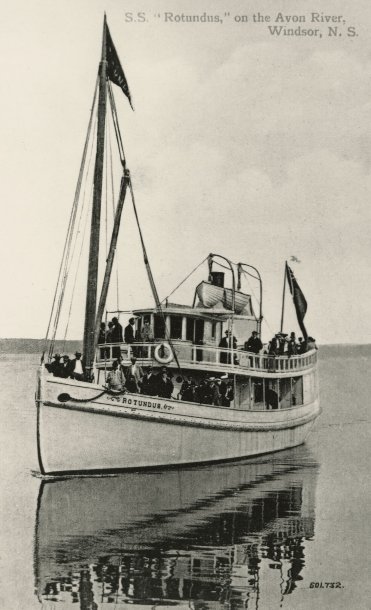
there, first they made them with tacks, and finally they stitched.
While I’m talking about the waterfront, the old Avon used
to come from Summerville to Hantsport to Burlington to Windsor and
back. They carried people, live stock, farm products, whatever.
She was followed by the Rotundus. It was a great thing to get
on and go to Windsor. He’d blow the whistle and you’d come rushing back
and get on the boat and come back home. On moonlight nights in
summer, they’d have moonlight excursions. I was too young to go
on any of those, but they were popular.
The gypsum business: they used to tow their barges loaded
with gypsum from Wentworth to the Basin and then a big ocean going
tug took them from there to the States, mainly Staten Island. She’d
take one, two or three barges in tow behind her. She used to come
in to Hantsport, the Gypsum King, a nice big ocean going tug, to
get water (that’s after the water system got in.) I had a dog
that my father had gotten me when I was four years old. When 1
10
was about seven, I guess, this terrible thing happened–the Captain
of the tug, Captain Blizzard, had a small dog something like
Jiggs’ Maggie’s spider-like dog, and my dog was forever going on
the tug boat to see this little dog. By golly, didn’t one day
the tug leave with my dog aboard. I didn’t know what to do. I
shouted to the crew, but they paid no attention to me and the tug
was out pretty far into the river, and I don’t know how far down
it was, and they threw Rex overboard. I thought, “By golly, he’ll
never make it.” Well, he did, but by the time he did I was down
by –about where Earl’s Creek is, the tide had taken him down as
he was swimming in. I was afraid,–I walked out, clothes and all,
as far as I could (I couldn’t swim much at that time) grabbed him by
the hair and hauled him in, and he lay in the beach and panted a
long while. Finally we both got home-all in–both of us. It was
a traumatic thing for me, having that dog go aboard that ship.
The wharves were there, the government wharf not at all like
it is today. It went straight out, with a small jog to the left.
Later they built it right over, pretty near to Prince Street, but
not into land. In next to the land was a great big building, a
sail loft left over from Churchill’s ship building days. Well,
the town started throwing in junk and there was a great big garbage
heap to the interior of the dock. It was full of rats and we used
to wait for the good high tide and go down there, because the rats
all came up on the wharf and we’d try to knock them off with stones
and sticks. Somebody had a rat terrier and he’d make short work
of those rats when they came up. But it was a terrible thing, as
long as it lasted, but eventually the pulp company built there.
The groundwood plant was on top of that; they did away with the sail
loft. The sail loft was a terribly big building. I was never
11
in it. It was always boarded up. It was one of the remnants of
the Churchill operation. Their office is still used by the Pulp
Company and the block mill which is the Union Hall now. I’m not
sure it was owned by Churchill, it made pulleys for the ships.
Those were the only remnants of shipbuilding.
Tug boats were used to get water in those days; there was no
water system. The tugboats went up the Halfway River and turned
up towards Prince Street because the old aboiteau is right next to
Prince Street and right back of what was then Embert Gollans
was a pipe and a big tank, and the tug boats got their water out of
this tank up at the head of the Halfway River. I can remember
going there to get water, water was a big thing. Pretty near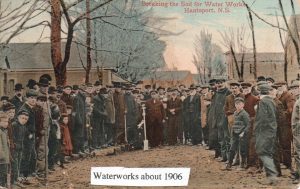
everyone had rain water and a well. Next thing I remember of note
was putting in the water system. It was a wonderful thing for
the town. A William Mulhall was in charge of it. They had a
devil of a time at first, pipes broke right and left because they
bought the cheapest pipe they could get their hands on.
A lot of people put in bathrooms. Unfortunately, a lot of them
used their old wells for a septic tank. It wasn’t until 1905 they
put a sewer system in. That was a good thing, as the streets as I
was saying earlier, were terrible. This allowed them to fix up
the streets and to have gutters. That was overseen by a man named
Bill Sutherland from Mount Denson. In 1914 or thereabouts, the
electrical system was put in. It got its power from Murray’s mill.
They’d start the thing up at dusk and turn it off at l2 o’clock.
They used to give a bit of a warning by opening and closing the
switch, then you either had to go to bed, or light candles or sit
in the dark–you had your choice.
12
And they didn’t come on again of course until next night, so you
had no electrical appliances. A few people had irons, that’s about
all, and power was very expensive so people didn’t have very many
bulbs lit at once. One thing that came about as a result of the
electrical system was the solving of the problem of pipes freezing.
They used to freeze right and left, and a part of the town in gravel,
which is from Prince Street to Tannery road and up to the top of
School Street, it’s all gravel, the rest is clay which isn’t so
bad, but the gravel part froze regularly and you’d have to borrow
water from a neighbour for weeks while you were frozen up. The
cure was to build big fires of cordwood on the street and dig out a
foot of gravel, start another fire, dig out another foot until the
frozen pipe was reached. This sometimes took days to get down
to the pipe and then thaw it. In the meantime, somebody else was
waiting for you to come around and thaw out theirs. Not only that,
but the hydrants froze and there was a time that I doubt more than
two or three hydrants in the town were working in case of fire.
-
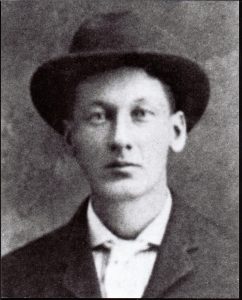
George Ferguson, Town Clerk
About 1918, the then town clerk, George Fergusson, asked me
if I could rig up the gear they had bought from General Electric
to thaw water. I tell you my knowledge of electricity was pretty
darn rudimentary. I knew a little bit about wiring houses as I
had bought a lot of books about that and I think I did good work on
that as the books were explicit and the rules were given there,
but as far as putting up transformers to thaw water, I had a very
vague idea about the whole thing. However, they sent sketches
and we got out what they called bob sleds that they hauled wood
on, put the two big transformers on that, two big reels of cable
and we would hook an end of the cable on the pipe where it came into
(pages missing)
